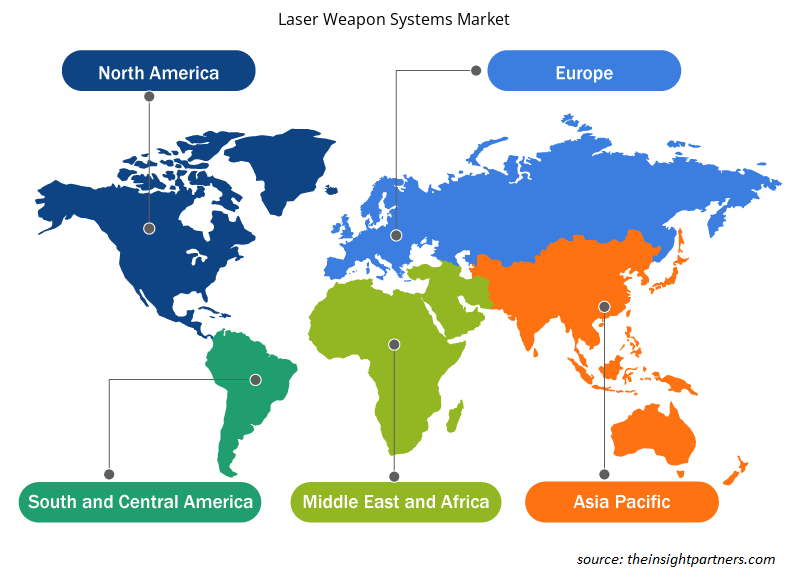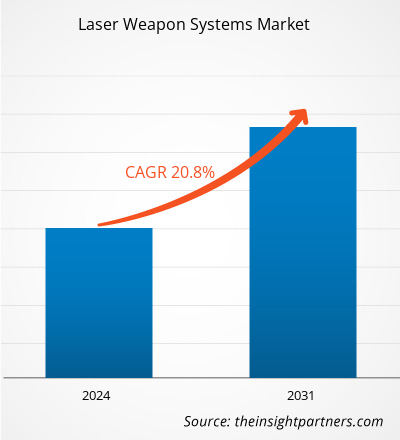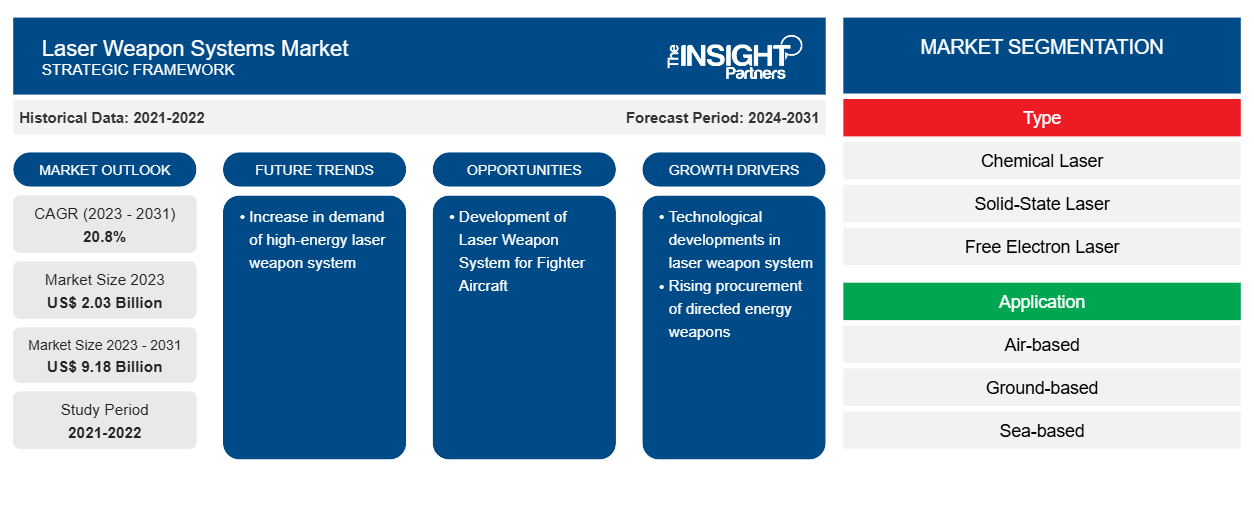Der Markt für Laserwaffensysteme soll von 2,03 Milliarden US-Dollar im Jahr 2023 auf 9,18 Milliarden US-Dollar im Jahr 2031 anwachsen. Der Markt wird zwischen 2023 und 2031 voraussichtlich eine durchschnittliche jährliche Wachstumsrate (CAGR) von 20,8 % verzeichnen. Die steigende Nachfrage nach Hochenergie-Laserwaffensystemen dürfte ein wichtiger Trend auf dem Markt bleiben.
Marktanalyse für Laserwaffensysteme
Lockheed Martin Corporation, L3Harris Technologies Inc., Leonardo DRS, Northrop Grumman Corporation und Rheinmetall AG gehören zu den wichtigsten Marktteilnehmern auf dem globalen Markt für Laserwaffensysteme. Die wichtigsten Akteure werden unter Berücksichtigung von Faktoren wie Gesamtumsatz, aktuellem Produktportfolio für Laserwaffensysteme, geografischer Reichweite, Marktinitiativen, Investitionen in Technologie-Upgrades, Partnerschaften und anderen marktbezogenen Aktivitäten aufgelistet.
Marktübersicht für Laserwaffensysteme
Das Ökosystem des Marktes für Laserwaffensysteme besteht aus den folgenden Interessengruppen: Komponentenhersteller, Hersteller von Laserwaffensystemen und Verteidigungskräfte. Die Akteure auf dem Markt für die Herstellung von Laserwaffensystemen beziehen Komponenten wie Sensoren, Nachführhalterungen, Strahlendetektoren und andere Ersatzteile von verschiedenen Lieferanten auf der ganzen Welt. Diese Lieferanten optimieren kontinuierlich ihre Produktionslinien und Vorlaufzeiten, um die jeweilige Lieferkette zu verbessern. Die Hersteller von Laserwaffensystemen verzeichnen aufgrund der in den letzten Jahren zunehmenden Bedrohung durch UAVs eine erhebliche Nachfrage nach ihren Produkten. Der Lieferant von Laserwaffensystemen arbeitet eng mit dem Einkäufer des Laserwaffensystems zusammen, um die Nachfrage des Einkäufers oder der Endbenutzer zu verstehen. Dies hilft den Herstellern von Laserwaffensystemen, die Bedürfnisse der jeweiligen Kunden angemessen zu erfüllen. Die Verteidigungskräfte sind die Endbenutzer, die weiterhin nach hochenergetischen, hochpräzisen und weitreichenden Laserwaffensystemen für ihre Verteidigungsflotte suchen. Mehrere Verteidigungskräfte arbeiten eng mit Herstellern von Laserwaffensystemen wie Raytheon Technologies, Lockheed Martin Corporation und anderen zusammen, um das bestmögliche System in die Verteidigungsflotte zu integrieren. Dieser Faktor treibt auch den Markt für militärische Laserwaffensysteme voran.
Passen Sie diesen Bericht Ihren Anforderungen an
Sie erhalten kostenlos individuelle Anpassungen an jedem Bericht, einschließlich Teilen dieses Berichts oder einer Analyse auf Länderebene, eines Excel-Datenpakets sowie tolle Angebote und Rabatte für Start-ups und Universitäten.
-
Holen Sie sich die wichtigsten Markttrends aus diesem Bericht.Dieses KOSTENLOSE Beispiel umfasst eine Datenanalyse von Markttrends bis hin zu Schätzungen und Prognosen.
Markttreiber und Chancen für Laserwaffensysteme
Technologische Entwicklungen bei Laserwaffensystemen
Verbesserungen in der Lasertechnik haben zu Hochenergielaserwaffen mit größerer Reichweite geführt. Laserwaffen entwickelnde Unternehmen wie Raytheon Technologies, Lockheed Martin Corporation und Dynetics Inc. führen neue Entwicklungen in der Lasertechnologie ein. Lockheed Martin beispielsweise treibt seine Bemühungen voran, Hochenergielaser und integrierte optische Blenden mit Überwachung (HELIOS) für die US-Marine bereitzustellen, indem es Langstrecken-ISR, Laserwaffen und Abwehrfähigkeiten für unbemannte Luftfahrzeuge kombiniert, um die Lageerkennung und die mehrschichtige Verteidigung zu verbessern. Ebenso hat Raytheon Technologies 15,5 Millionen US-Dollar Aufträge für die Entwicklung eines verbesserten, auf Buggys montierten Laserwaffensystems vergeben. Die Waffe kann Drohnen oder kleine unbemannte Flugsysteme innerhalb von 3 km mit einem spielbaren Controller und einem Laptop zerstören.
Entwicklung eines Laserwaffensystems für Kampfflugzeuge
Laserwaffensysteme erfreuen sich einer großen Nachfrage in Ländern mit weltweit hoher Militärmacht wie den USA, Russland, China und Indien. Die fortschreitende Waffenentwicklung und die steigende Zahl von Drohnen in Militäroperationen schaffen eine Nachfrage nach modernen Verteidigungswaffen . Eine große Zahl von Drohnen und modernen Waffen kann schweren Schaden anrichten, weshalb die Nachfrage nach hochpräzisen Laserwaffensystemen steigt. Steigende Investitionen verschiedener Nationen und wichtige F&E-Aktivitäten der Marktakteure schaffen neue Möglichkeiten für das Wachstum des Marktes. So eröffnet beispielsweise die US-Initiative SHiELD (Self-Protect High-Energy Laser Demonstrator) ein neues Anwendungsgebiet für Laserwaffensysteme. Lockheed Martin entwickelt derzeit ein Laserwaffensystem für Kampfjets, das den Fortschritt der Kriegsführung auf ein neues Niveau hebt. Die Laserwaffen in Kampfjets ermöglichen es, Raketen im Flug abzuschießen und sich so einen Vorteil gegenüber dem Gegner zu verschaffen.
Segmentierungsanalyse des Marktberichts zu Laserwaffensystemen
Schlüsselsegmente, die zur Ableitung der Marktanalyse für Laserwaffensysteme beigetragen haben, sind Typ und Anwendung.
- Basierend auf dem Typ ist der Markt für Laserwaffensysteme in chemische Laser, Festkörperlaser, Freie-Elektronen-Laser und Faserlaser unterteilt. Das Faserlasersegment hatte im Jahr 2023 einen größeren Marktanteil.
- Basierend auf der Anwendung ist der Markt für Laserwaffensysteme in luftgestützte, bodengestützte und seegestützte Systeme unterteilt. Das bodengestützte Segment hatte im Jahr 2023 einen größeren Marktanteil.
Marktanteilsanalyse für Laserwaffensysteme nach geografischer Lage
Der geografische Umfang des Marktberichts zu Laserwaffensystemen ist hauptsächlich in vier Regionen unterteilt: Nordamerika, Europa, Asien-Pazifik und Rest der Welt.
Nordamerika dominierte den Markt im Jahr 2023, gefolgt von Europa und dem asiatisch-pazifischen Raum. Darüber hinaus wird der asiatisch-pazifische Raum in den kommenden Jahren voraussichtlich die höchste durchschnittliche jährliche Wachstumsrate verzeichnen. Die USA hatten den größten Anteil am nordamerikanischen Markt für Laserwaffensysteme. In den USA tätige Unternehmen setzen auf die Einführung neuer Technologien, um Leistung, Genauigkeit und Design zu verbessern. Die zunehmende Anzahl von Waffen in den US-Streitkräften ist ein wichtiger Faktor für das Marktwachstum, da die Unternehmen fortschrittliche Laserwaffensysteme entwickeln, um Luftangriffe zu verhindern. Darüber hinaus ist die zunehmende Verbesserung der Waffensysteme der Marine mit verbesserter Durchdringung von Laserwaffensystemen ein Schlüsselfaktor, der das Marktwachstum steigert. Laut den neuesten Daten von Global Firepower sind die USA das führende Land in Bezug auf die militärische Stärke mit hoher Personalstärke und Arsenalen. Die US-Marine setzt kontinuierlich Laserwaffensysteme ein und rüstet sie auf, um den Schutz vor Luftangriffen zu verbessern.
Regionale Einblicke in den Markt für Laserwaffensysteme
Die regionalen Trends und Faktoren, die den Markt für Laserwaffensysteme im Prognosezeitraum beeinflussen, wurden von den Analysten von Insight Partners ausführlich erläutert. In diesem Abschnitt werden auch die Marktsegmente und die Geografie von Laserwaffensystemen in Nordamerika, Europa, im asiatisch-pazifischen Raum, im Nahen Osten und Afrika sowie in Süd- und Mittelamerika erörtert.

- Erhalten Sie regionale Daten zum Markt für Laserwaffensysteme
Umfang des Marktberichts zu Laserwaffensystemen
| Berichtsattribut | Details |
|---|---|
| Marktgröße im Jahr 2023 | 2,03 Milliarden US-Dollar |
| Marktgröße bis 2031 | 9,18 Milliarden US-Dollar |
| Globale CAGR (2023 - 2031) | 20,8 % |
| Historische Daten | 2021-2022 |
| Prognosezeitraum | 2024–2031 |
| Abgedeckte Segmente |
Nach Typ
|
| Abgedeckte Regionen und Länder |
Nordamerika
|
| Marktführer und wichtige Unternehmensprofile |
|
Marktteilnehmerdichte: Der Einfluss auf die Geschäftsdynamik
Der Markt für Laserwaffensysteme wächst rasant, angetrieben durch die steigende Nachfrage der Endnutzer aufgrund von Faktoren wie sich entwickelnden Verbraucherpräferenzen, technologischen Fortschritten und einem größeren Bewusstsein für die Vorteile des Produkts. Mit steigender Nachfrage erweitern Unternehmen ihr Angebot, entwickeln Innovationen, um die Bedürfnisse der Verbraucher zu erfüllen, und nutzen neue Trends, was das Marktwachstum weiter ankurbelt.
Die Marktteilnehmerdichte bezieht sich auf die Verteilung der Firmen oder Unternehmen, die in einem bestimmten Markt oder einer bestimmten Branche tätig sind. Sie gibt an, wie viele Wettbewerber (Marktteilnehmer) in einem bestimmten Marktraum im Verhältnis zu seiner Größe oder seinem gesamten Marktwert präsent sind.
Die wichtigsten auf dem Markt für Laserwaffensysteme tätigen Unternehmen sind:
- Elbit Systems Ltd.
- L3Harris Technologies, Inc.
- LOCKHEED MARTIN CORPORATION
- MBDA
- Northrop Grumman Corporation
- Raytheon Technologies Corporation
Haftungsausschluss : Die oben aufgeführten Unternehmen sind nicht in einer bestimmten Reihenfolge aufgeführt.

- Überblick über die wichtigsten Akteure auf dem Markt für Laserwaffensysteme
Marktnachrichten und aktuelle Entwicklungen zu Laserwaffensystemen
Der Markt für Laserwaffensysteme wird durch die Erhebung qualitativer und quantitativer Daten nach Primär- und Sekundärforschung bewertet, die wichtige Unternehmensveröffentlichungen, Verbandsdaten und Datenbanken umfasst. Nachfolgend sind einige der Entwicklungen auf dem Markt für Laserwaffensysteme aufgeführt:
- Das von BlueHalo zur Unterstützung des Rapid Capabilities and Critical Technologies Office (RCCTO) der US-Armee entwickelte Palletized High Energy Laser (P-HEL)-System hat sich bei der Bekämpfung und Beseitigung von Bedrohungen durch kleine unbemannte Luftsysteme (sUAS) für Streitkräfte und kritische Infrastrukturen bewährt – ein schnell wachsendes Problem für die Dominanz der USA auf dem Schlachtfeld. BlueHalo erhielt einen vierjährigen Logistik-Supportvertrag zur Bereitstellung von vorbeugender und korrektiver Wartung sowie Schulungen für Bediener und Wartungsteams für das P-HEL-System von BlueHalo. Dieser neu vergebene Vertrag etabliert BlueHalo als führenden Systemintegrator für den gesamten Zyklus von der Prototypenentwicklung bis zum Frontbetrieb des P-HEL-Systems. (Quelle: BlueHalo, Pressemitteilung, April 2024)
- Raytheon UK wird sein erstes Hochenergie-Laserwaffensystem erhalten, das im Vereinigten Königreich getestet und integriert werden soll. Dies stellt einen bedeutenden Fortschritt im Verständnis dar, wie solche Systeme eingesetzt werden können. (Quelle: Raytheon Technologies Corporation, Pressemitteilung, September 2023)
Marktbericht zu Laserwaffensystemen – Umfang und Ergebnisse
Der Bericht „Marktgröße und Prognose für Laserwaffensysteme (2021–2031)“ bietet eine detaillierte Analyse des Marktes, die die folgenden Bereiche abdeckt:
- Marktgröße und Prognose für Laserwaffensysteme auf globaler, regionaler und Länderebene für alle wichtigen Marktsegmente, die im Rahmen des Berichts abgedeckt sind
- Markttrends für Laserwaffensysteme sowie Marktdynamiken wie Treiber, Einschränkungen und wichtige Chancen
- Detaillierte Porter-Fünf-Kräfte-Analyse
- Marktanalyse für Laserwaffensysteme mit Blick auf wichtige Markttrends, globale und regionale Rahmenbedingungen, wichtige Akteure, Vorschriften und aktuelle Marktentwicklungen
- Branchenlandschaft und Wettbewerbsanalyse, einschließlich Marktkonzentration, Heatmap-Analyse, prominenten Akteuren und aktuellen Entwicklungen auf dem Markt für Laserwaffensysteme
- Detaillierte Firmenprofile
- Historische Analyse (2 Jahre), Basisjahr, Prognose (7 Jahre) mit CAGR
- PEST- und SWOT-Analyse
- Marktgröße Wert/Volumen – Global, Regional, Land
- Branchen- und Wettbewerbslandschaft
- Excel-Datensatz
Aktuelle Berichte
Verwandte Berichte
Erfahrungsberichte
Grund zum Kauf
- Fundierte Entscheidungsfindung
- Marktdynamik verstehen
- Wettbewerbsanalyse
- Kundeneinblicke
- Marktprognosen
- Risikominimierung
- Strategische Planung
- Investitionsbegründung
- Identifizierung neuer Märkte
- Verbesserung von Marketingstrategien
- Steigerung der Betriebseffizienz
- Anpassung an regulatorische Trends























 Kostenlose Probe anfordern für - Markt für Laserwaffensysteme
Kostenlose Probe anfordern für - Markt für Laserwaffensysteme